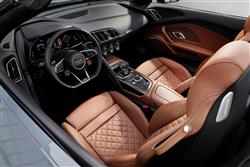SPYDER'S STING (some text hidden) --NONE--
By Jonathan Crouch
Introductionword count: 97
In second generation guise, Audi's formidable R8 supercar also came in Spyder form - that's 'without a roof'. With this supercar sports convertible - examined here in updated post-2019-era form - you still get all the good stuff, which means a 5.2-litre FSI V10 engine screaming away just behind your head. It's just that with this variant, you'll be able to hear it even more bit more clearly. Plus the R8 Spyder can be a real driver's tool in this last combustion form, with a rear-driven variant joining the familiar quattro model. Still want that used Ferrari?
Modelsword count: 6
2dr Convertible (5.2 V10 - 570PS/620PS])
Historyword count: 202
An Audi supercar was the last thing anyone would have expected back in the '80s and '90s when customers had the choice of only three Audi models and weren't buying any of them in any great numbers. By the end of this new century's second decade though, the Ingolstadt maker's range had become vast and the R8's existence was taken for granted. Sharing many components with its VW Group cousin the Lamborghini Huracan, this model was a symbol of how far Audi had progressed and of all the R8 derivatives, it could be this Spyder convertible that best showcased the brand's all-conquering ambition. The first generation 'Type 42' R8 Spyder model was launched back in 2008, two years after the Coupe version, with this MK2 'Type 4S' version first arriving in 2015, aiming to be a little less of a style statement and a little more dynamically adept. Enhanced Audi Space Frame technology allowed it to deliver on that promise, encouraging Audi to further improve the 5.2-litre V10 engine's performance for the facelifted model we look at here, launched in 2019, its range broadened by the addition of rear-driven derivatives in 2021. R8 Spyder sales finished in at the end of 2023.
What You Getword count: 577
Visually, the R8 Spyder remains a distinctive cocktail of low-slung curves and delightful design extravagance, though in this improved version of the second generation model, the influential shape of the original 'Type 4S' design is expressed in a tauter, more technically precise way. As before, we're talking Ferrari - but with a German twist. This design's elegant, lightweight fabric top, with its largely aluminium and magnesium linkage, perfectly complements this R8's lightweight design approach - kerb weight's just 1,695kg in the quattro model. Just 44kgs of that is accounted for by the roof, which opens or closes in just 20 seconds at speeds of up to 31mph. You'd usually activate the process from inside the car but you can also do so from outside by using the standard 'Advanced Key'. The hood mechanism's acrobatics deliver an intricate piece of street theatre, the hood compartment cover moving fluidly on two seven-link hinges. When closed, the top integrates neatly into the design line, stretching low above the body and extending to the rear in two long slender fins. Otherwise, the design of this Spyder model is familiar from its Coupe counterpart. So, as with that body style, horizontal lines define the front end with its huge sculptural Singleframe radiator grille. Audi took the opportunity in 2018 to introduce a package of updates to this second generation R8, the visual changes made being extremely subtle. The Singleframe radiator grille has a wider, flatter line. Thick bars divide up the large air inlets, and flat slits in the hood are reminiscent of the Audi Ur-quattro brand icon. Plus the smarter front splitter is wider, underscoring the focused look. Inside, you're introduced to what the Ingolstadt brand calls a 'luxury-level racing atmosphere' and an interior that remains an object lesson in how to package a two seat sportscar. As before, one of the cockpit's key distinguishing features is what the stylists call the 'monoposto', a stylised large arc that encircles the driver's area of the cockpit, starting in the door and ending at the centre tunnel. But if that's familiar, you'll also find plenty that's different if you've yet to experience this post-2015-era second generation 'Type 4S' model, the changes beginning with the grippy, flat-bottomed R8 performance steering wheel. With the second generation R8, extra round satellite buttons were added to control engine start-up and driving dynamics. Plus there are two further smaller round controls - a dial on the left to set the car up for different weather conditions and a button on the right to alter the exhaust note. As for all the infotainment functionality, well that's is located in the 'Audi Virtual Cockpit', a 12.3-inch high resolution instrument binnacle display screen that presents all necessary information in richly detailed, high-resolution 3D graphics. And beyond that? Well, were we to be graduating into this car from a 911 Cabriolet, we'd miss the little rear seats that Porsche give you there, so useful for chucking a jacket or a designer shopping bag on to. The lack of storage space behind the seats is quite significant because the room you actually get in the boot is extremely restricted. At 112-litres in size (the same as in an R8 Coupe), this trunk offers less than half the amount of luggage space you'd get in, say, a rival Mercedes-AMG GT C Roadster from this period. To be fair, the boot beneath the bonnet of a rival 911 Turbo Cabriolet is about the same size.
To see the full road test text contact us on 0330 0020 227
Pictures (high res disabled)

.jpg)
|
.jpg)
|
.jpg)
| |||
.jpg)
|
.jpg)
|
.jpg)
| |||
.jpg)
|

|
Scoring (subset of scores)
Category: Sporting Cars
| Performance | |
| Handling | |
| Comfort | |
| Space | |
| Styling, Build, Value, Equipment, Depreciation, Handling, Insurance and Total scores are available with our full data feed. | |



